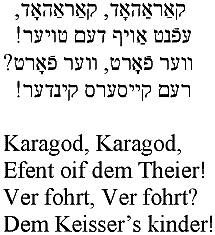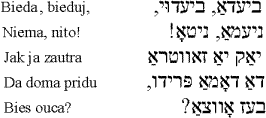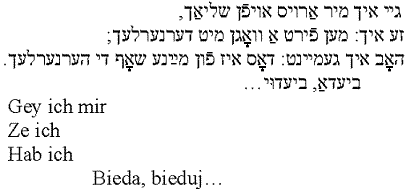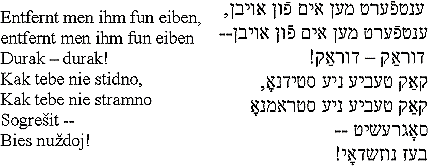Notes:
1. F.J. Beranek, "Jiddisch" in Deutsche Pihilologie im Aufris, ed. W. Stammler, vol. 1, cols. 1551-1590,
Berlin-Bielefild, 1953.
Cf. also Robert Joseph Tamushanski, German Loanwords in Middle Byelorussian Ph.D. thesis, London University, August 1974, p. 50.
2. Uriel Weinreich, "Yiddish and Colonial German in Eastern Europe: The Differential Impact of Slavic" in American Contributions to the Fourth International Congress of Slavicists, Moscow, 1948, pp. 372-374.
3. S. M. Dubnov, History of the Jews in Russia and Poland from the Earliest Times until the Present Day, vol. 1: From the Beginning until the Death of Alexander I (1825), (trans. J. Friedlaender). Philadelphia, 1946, pp. 41, 43, 59-60.
Cf. also R. J. Tamushanski, op. cit., pp.82-84.
4. Dubnov, op. cit., p. 67. Tamushanski, op. cit., p. 84.
5. G. M. Meredith-Owens and Alexander Nadson, "The Byelorussian Tartars and their Writings" in Journal of Byelorussian Studies, [London], vol. 2, no. 2, 1970, pp. 141-176.
6. Zmitrok Biadulia, "Rukapis carnakniznika XVIII vieku (Bahatyja matarjaly pa bielaruskaj etnahrafii)" in Volny Sciah, Minsk, December 1921, pp. 33-35.
7. Ibid., pp. 34-35.
8. Uriel Weinreich, "Di forsung fun 'missparakike' jidise folkslider" in YIVO Bleter, [New York], 1950, pp. 282-288.
Cf. also Musij Berehovskjy, "Cuzomovni I riznomovni pisni v Jevreiv Ukrainy, Bilorusi j Polsci" in Etnohrafycnyj Visnik, VI/9, 1930, pp.37-51.
Examples of Yiddish folk songs from Belarus:














 |
|---|
 |


